I just learned via a brochure I picked up this weekend that there is a museum only 15 miles (25 kilometers) away in Bruchmühlbach-Miesau dedicated to the invention and development of der Staubsauger. It looks like a lot of fun. But what is this clever device? Der Staub is dust, and saugen means to suck. So der Staubsauger is a vacuum cleaner.
It’s a Small World After All
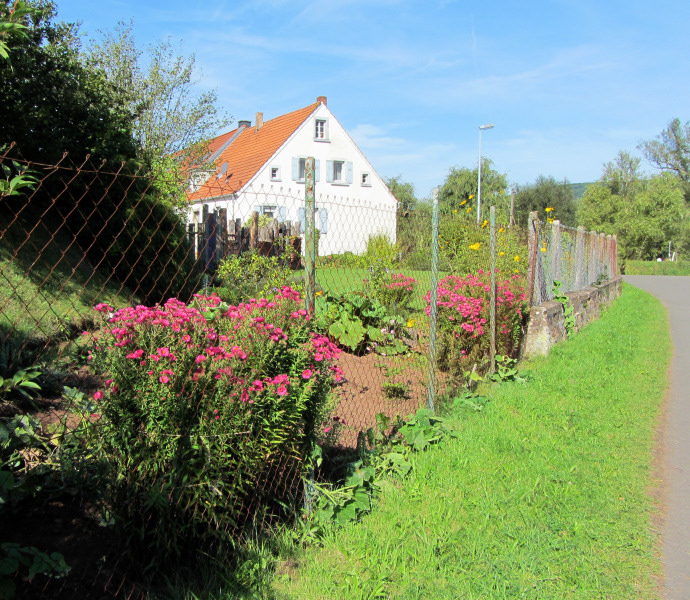
It’s a beautiful day, and I’ve just returned from a walk through the gorgeous German countryside, where I snapped the photo above. I decide to share my good mood and call my grandmother back home in Texas. “Hello?! Hello?!” Her voice has that hysterical tone that means one of two things. Either a grenade has just gone off in her living room, or I’ve forgotten about the time change again.
Grandmama is in her mid-nineties. She doesn’t need this kind of stress.
When Joe and I first came over here in 2000, the time change hardly mattered. We wrote our emails on clay tablets back then, and good calling plans didn’t exist. But now, I’ve got unlimited free calling to and from the States on my cell phone for only five bucks a month. (Thank you, Sipdroid and Pbxes.com!) But there are still these completely outdated processes called “sunrise” and “sunset” that keep reminding me just how far away I am.
After almost killing my grandmother, I downloaded a great widget for my Android phone called TM World Clock:
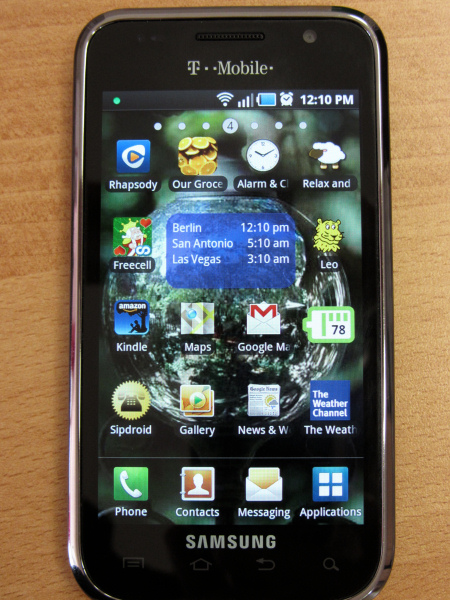
It keeps me from making stupid phone calls, but it can’t keep me from saying stupid things once I’m on the phone, as I did yesterday when I called the T-Mobile rep at midnight. “Have a good night!” I told him cheerfully. Then I realized that he was still living through late afternoon.
“Um…okay,” he replied with understandable caution.
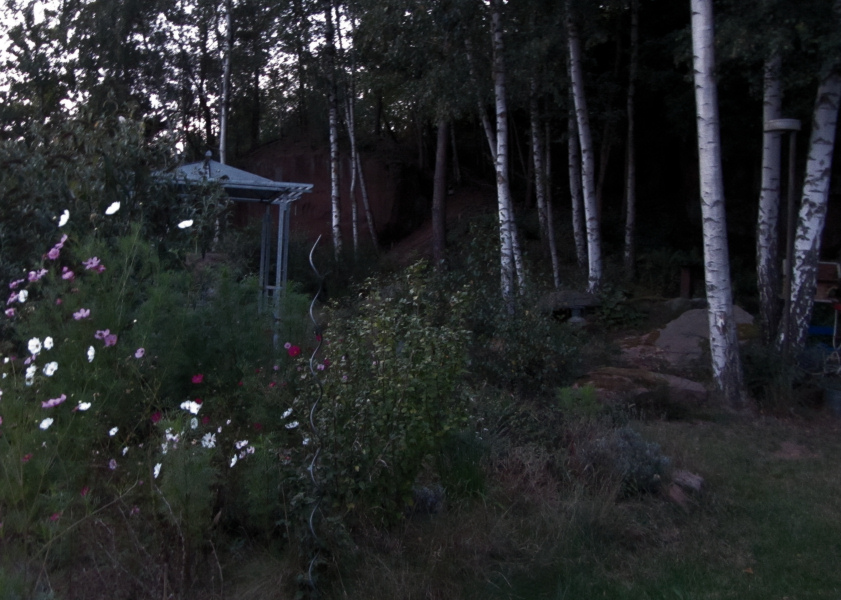
Dusk is falling. We’re drinking wine with our friends Rainer and Heidi and admiring their garden in the late twilight. But I still can’t call my daughter in Texas. She’s not home from nursing school.
Midnight. Is that a grenade going off in my living room? No, it’s the phone. “Hello?! Hello?!” I shriek.
“Go back to bed, woman!” sounds my daughter’s firm voice in my ear. “I’ll call you in the morning.”
Her morning, that is, which is my…oh, never mind.
Photographs taken September, 2011, in Rodenbach, Germany. Text copyright 2011 by Clare B. Dunkle. Photos copyright 2011 by Joseph R. Dunkle.
It’s been rainy and chilly. Last night was a crisp 43 degrees F (6 degrees C). Today is beautiful, though, sunny and hot–unseasonably warm for September. But it isn’t the start of Indian summer, as my friend Heidi points out. Her European ancestors weren’t troubled by Indian raids during the unseasonably warm nights of autumn. Instead, it may be the start of der Altweibersommer: the old crones’ or old shrews’ summer. Weib is not at all a nice word for a woman, but these alte Weiber aren’t your regular women. They refer to the white gossamer threads and nets of spiders, which stand out clearly in the early morning dew after one of the cool Altweibersommer nights. Ancient Europeans associated these webs with the white hairs of the Norns, three goddesses who wove and snipped the threads of destiny. They were the ones who sent men to their deaths–old shews indeed!
My Last Garden, continued
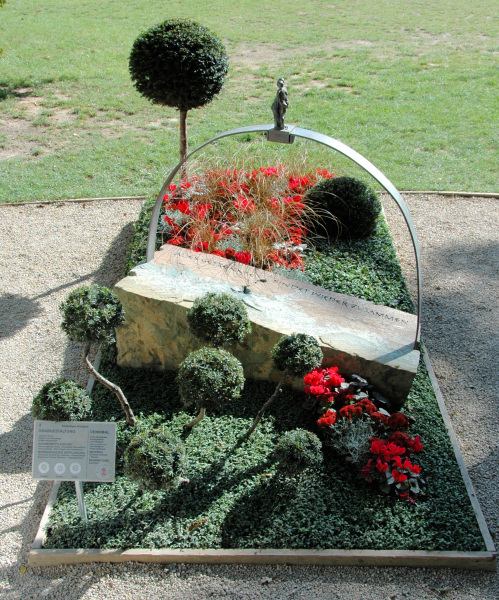
Joe and I found the example graves at the Koblenz National Garden Show completely fascinating. They were so unlike anything we’d seen. Some were as elaborate and elegant as a Japanese flower arrangement. Others were just downright different. Joe’s favorite by far was the specimen below, commemorating an avid bowler.
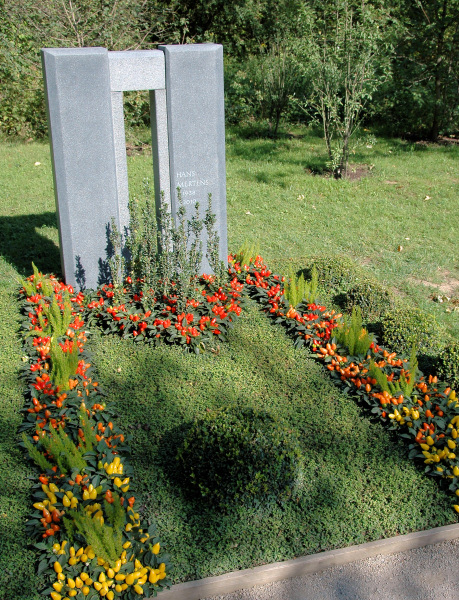
Yep, that’s a little bowling ball bush in the foreground, and those are bowling pins at the back.
But my favorite was this charming little number featuring a gracefully curved feather pen. Was it really–? Could it be–?
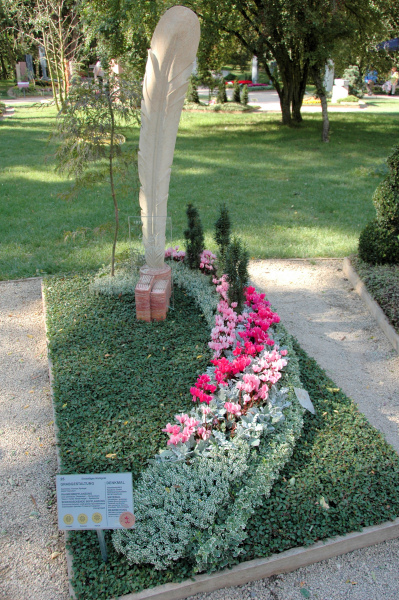
I examined the glass plaque, and there it was, below an entirely illegible signature:
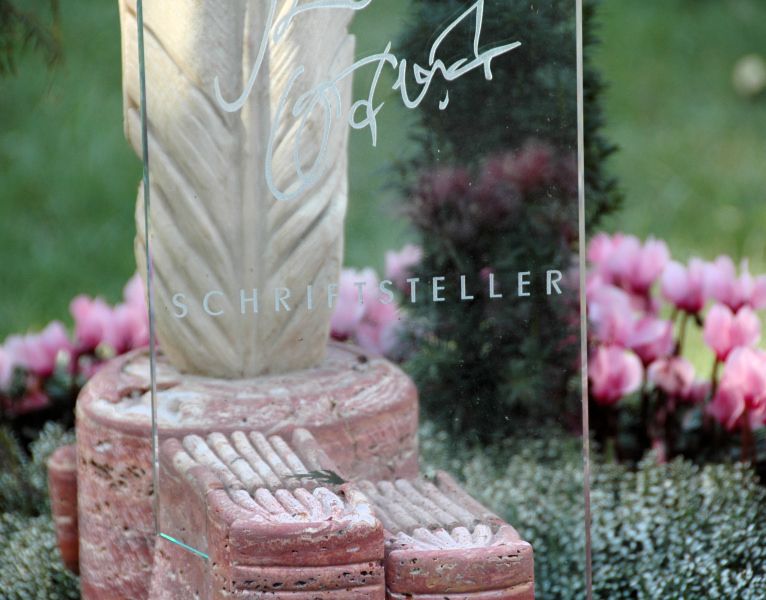 ‘
‘
Schriftsteller. Writer. Author. Wordsmith. Gone to his last signing!
Photographs taken September, 2011, in Koblenz, Germany. Text copyright 2011 Clare B. Dunkle. Photos copyright Joseph R. Dunkle.
My box of German cereal informs me that I’m getting 3,7 grams of Ballaststoffe in every serving. Now, I know that die Stoffe is stuff–or, to put it a nicer way, material. And I can guess pretty quickly that der Ballast is dead weight, freight–in other words, ballast. So Ballaststoffe must be the indigestible “dead weight” that comes in a food along with its calories and vitamins. Die Ballaststoffe is fiber, the stuff that keeps your digestion on an even keel.
My Last Garden
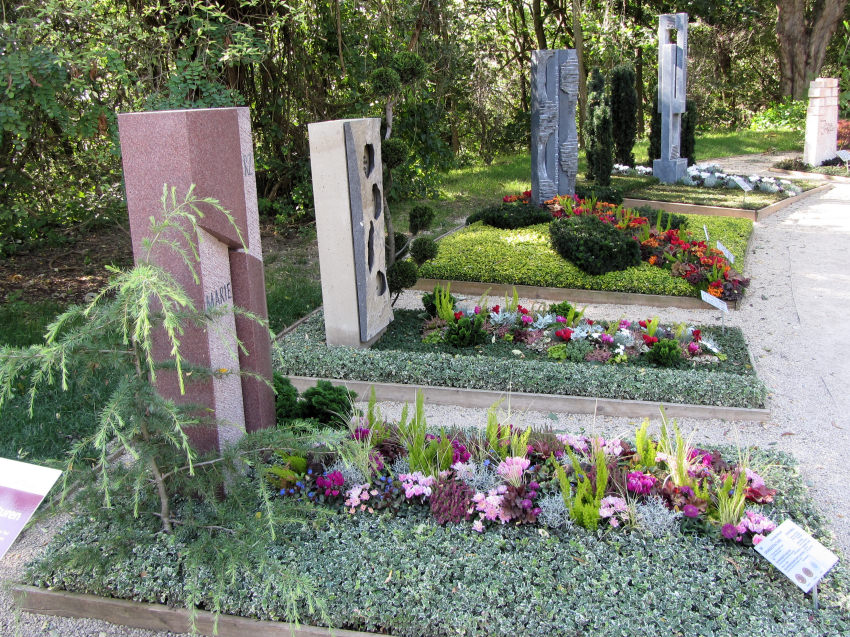
Graves. Headstones. Birth and death dates. Are we in a cemetery? No, we’re back at the Koblenz National Garden Show, where the program assures us, “a romantic woodland glade is the perfect setting for cemetery landscapers and stonemasons to demonstrate their skills in creative grave design.”
One of the first places Joe and I visited upon arriving here in 2000 was the local cemetery. It was so astonishingly beautiful! An American’s idea of grave care is to put out a pot of poinsettias at Christmastime, but many Germans visit the cemetery every day. So the Koblenz National Garden Show gave proper place to this small but very important garden–“My Last Garden,” as they called the exhibition. It was heavily attended, and the attendees were all but taking notes.
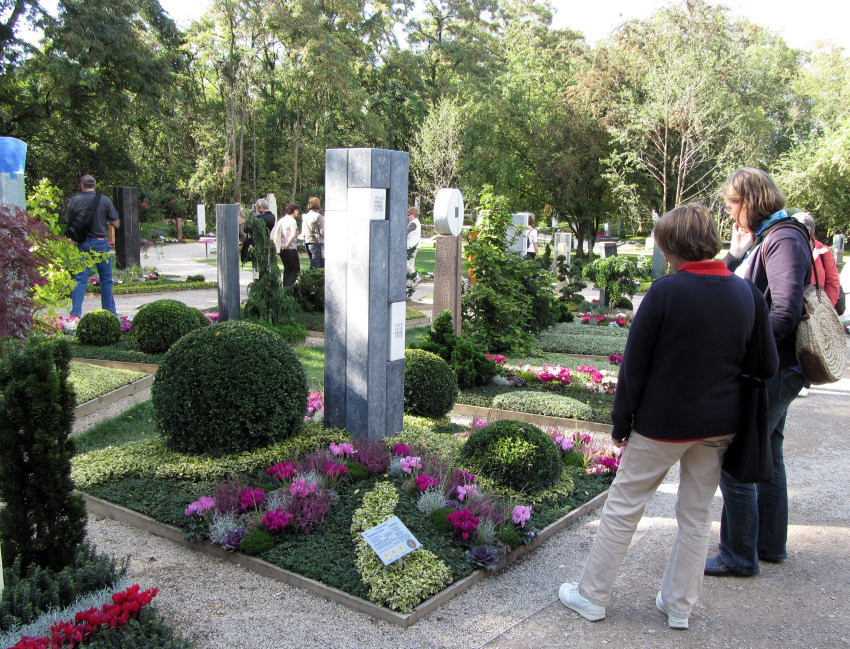
Why is the cemetery so important in Germany? I don’t know. Maybe it’s because the climate allows flowers to bloom here so easily. Maybe it’s because towns can be small and competitive feelings can run high. Maybe it’s because Germans rent a grave for only a couple of decades, so they understand that it belongs as much to the survivor as it does to the deceased. Maybe it’s because two devastating European wars within recent memory gave rise to a culture of widowhood, and this is a holdover from that time.
In any case, the exhibition contained examples of gorgeous art and lovely gardening. It could revolutionize the German cemetery–at least until this generation’s plot leases are up. (After that, the headstones are removed and the graves are reused.)
Placards encouraged attendees to express their loved one’s personality through headstone and plant choice, and that gave rise to some very quirky exhibits. Like the one below, for example–one imagines the headstone reading, “Paul. He shouldn’t have gotten that last industrial.”
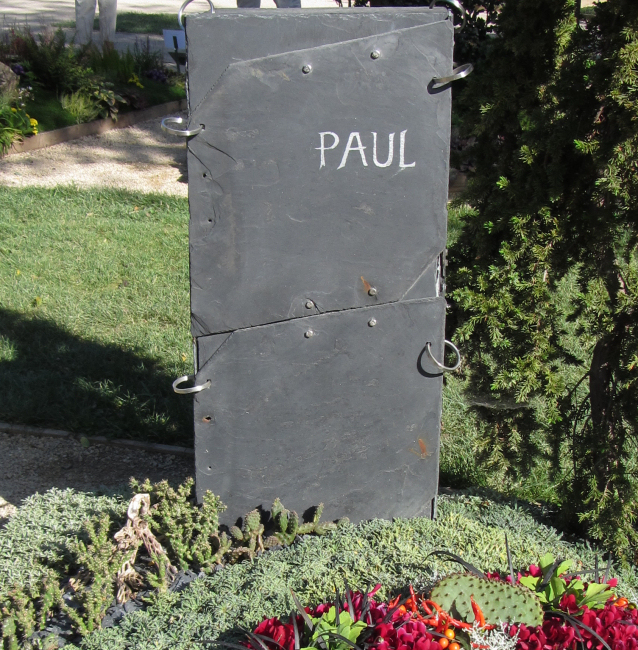
Tomorrow: A novelist’s final resting place.
Photographs taken September, 2011, in Koblenz, Germany. Text and photos copyright 2011 Clare B. Dunkle.
As I flip channels on my German television set, by far the most surreal experience I can have is pausing on channel 29, TV5Monde: French television with German subtitles. The juxtaposition highlights how almost ostentatiously different the languages of these two neighbors are. I can watch for fifteen minutes and not find a single cognate word. Yesterday I got caught up in a Versailles drama in which grown men were stomping, shouting, and even throwing their long curly wigs across the room over die Wut des Königs. The what of a king? Turns out, Wut means rage or anger–definitely a good reason to throw your wig! And predictably, at the center of all this Wut was a pretty young thing who wasn’t interested in anybody’s Wut but her own.
Carried Off by a Chill

This weekend, I woke up with a cold. My body ached, my nose was stuffy, and I felt weak and miserable.
Now, the American thing to do is to think about where I picked up the germ, so I thought back over the last few days. There was the plane trip, of course, as well as the young woman in Customer Service the other day who coughed on my receipt. We Americans are all about disease transmission. But the German thing to do is to think about when I got chilled. Getting chilled is a fact of life in this land of changeable wet weather, and I got chilled on Thursday afternoon when I took a brisk walk and came home with cold feet and a runny nose. Many Americans are scornful of this idea, but research does appear to show that if cold germs are already present in your system, becoming chilled can cause a mild asymptomatic infection to develop into the Real Thing.
I went down to the Apotheke and picked up the cold remedy pictured above because it contains elderberry extract. Europeans have been using elderberry against colds for thousands of years, as we all know from Hans Christian Andersen’s “The Little Elder-Tree Mother,” possibly the first description of a drug trip in children’s literature. Medical studies have found that elderberry extract contains a powerful antiviral agent that can cure the flu within a couple of days. So I took my elderberry remedy, and I drank hot elderberry tea, and I ate elderberry jam on my toast, too, just to make sure. Elderberry jam tastes like a cross between blueberries and dark sweet cherries.
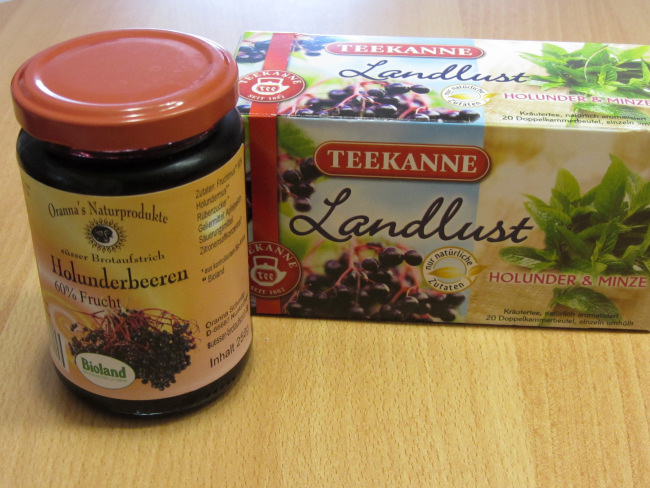
It’s Monday morning. After two days of feeling awful, I’m completely symptom-free. So I don’t laugh at old wives’ tales. There’s a reason those wives lived to be old!
German television is loaded with animal and nature shows. On one of them yesterday, a vet was showing off a litter of baby bunnies while their mother hovered nervously nearby. The little fist-size furballs tried to follow him out of the hutch, but he gently pushed them back and said, “You stay here, or mama will be zickig.” Zickig: touchy, uptight, catty. Used to describe women. Not a nice word, but here it works.
A Circular Reference in Stone
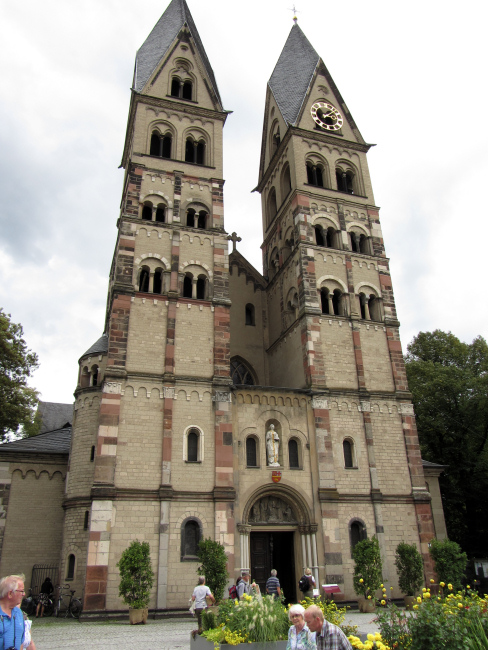
Around the corner from the Deutsches Eck in Koblenz is a church that has stood, more or less (in spite of being renovated, bombed, and shot at) for the last twelve hundred years. This is the beautiful Kastorkirche, the Basilica of St. Castor of Karden.
How can you tell it’s St. Castor’s Basilica? Because there’s a statue of St. Castor right over the door. And how can you tell he’s St. Castor? Because he’s holding a little copy of a church. Which church is he holding? As you can plainly see, it’s the Basilica of St. Castor. The same church which is currently holding him!
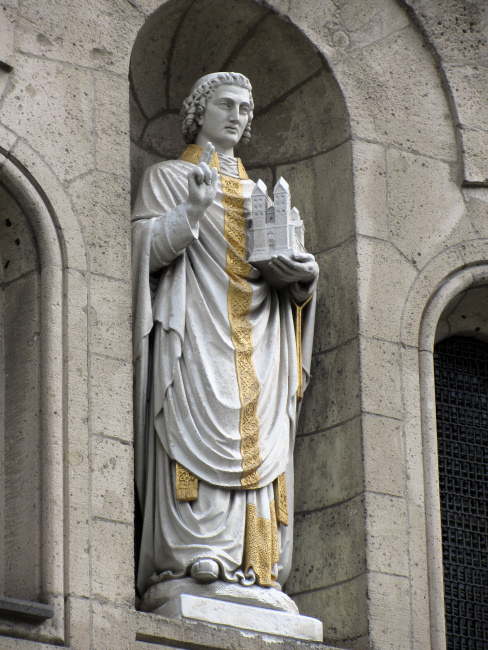
Saints in art usually carry or stand next to something that’s associated with them, a kind of shorthand that Catholics know. But St. Castor of Karden’s life doesn’t lend itself easily to iconography. He was a holy hermit by the Mosel River in the 4th century who brought the Christian faith to the Rhineland-Palatinate region. But it’s hard to make a statue out of that.
No, when it comes down to it, what St. Castor is famous for is the Basilica of St. Castor, so that’s what he always carries. Even when he’s part of the Basilica of St. Castor.
This sort of metaphysical circularity folded my gray matter like origami. Was there a little statue of St. Castor over the door of the church he was carrying? And did it, too, have its own tiny copy of the church? I imagined a series of matryoshka nesting churches getting smaller and smaller, each with their own statue-cum-church. Meanwhile, I couldn’t help looking for a great pair of hands to reach down from the heavens and cradle the ancient basilica.
Those hands are there, I’m sure. But it would take better eyes than mine to see them.
Inside, I met this delightful couple: Friedrich von Sachsenhausen and his wife, Sophie Schenk von Liebenstein, from the early 1400s.
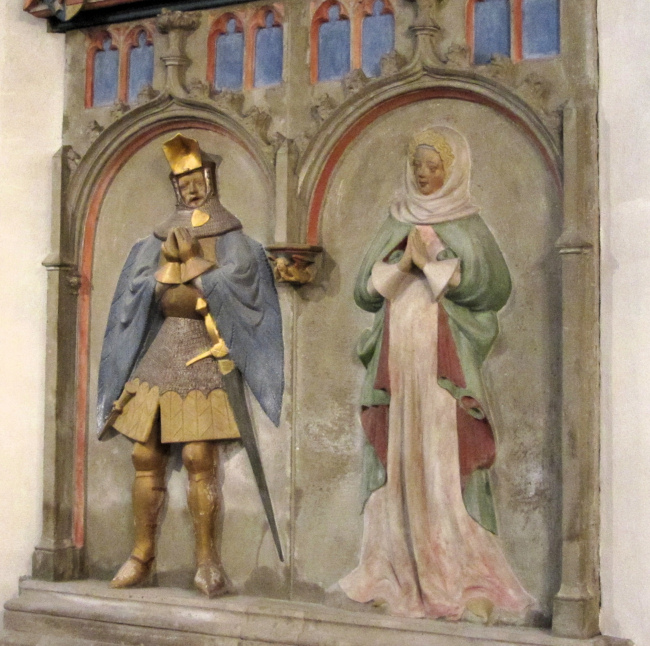
Photographs taken September, 2011, in Koblenz, Germany. Text copyright 2011 Clare B. Dunkle. Photos copyright 2011 Joseph R. Dunkle.
